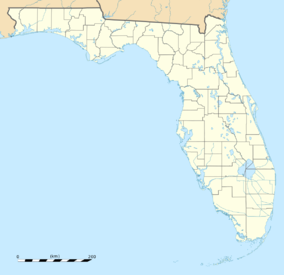Torreya State Park
| Torreya State Park | |
|---|---|
|
IUCN category V (protected landscape/seascape)
|
|

View of the Apalachicola River from bluffs
in Torreya State Park |
|
| Location | Liberty County, Florida, United States |
| Nearest city | Bristol, Florida |
| Coordinates | Lua error in package.lua at line 80: module 'strict' not found. |
| Area | 13,735 acres (56 km²) |
| Governing body | Florida Department of Environmental Protection |
| Designated | December 1976 |
Torreya State Park is a 13,735 acre (56 km²) Florida State Park, U.S. National Natural Landmark and historic site thirteen miles (19 km) north of Bristol. It is located north of S.R 12 on the Apalachicola River, in northwestern Florida (Florida Panhandle), at 2576 N.W. Torreya Park Road. It was named for a rare species of Torreya tree which only grows on the river bluffs.
Contents
Geography
With river swamps and high pinelands, extensive ravines and high bluffs along the river, the park has one of the most variable terrains of any in Florida. The high elevation of the park is about 300 feet at the top of Logan Hill. Many streams run through the park
History
Prior Native American inhabitation has been confirmed by archaeological discoveries in the area.
In 1818, General Andrew Jackson and his army crossed the Apalachicola here during the first Seminole Indian War. Ten years later, the first government road to cross the new Territory met the river here.
Due to the river's importance during the Civil War, a six-cannon battery was placed on a bluff to prevent the passage of Union gunboats. These cannons never saw combat action at this location. The gun pit's remains can still be seen in the park.
Gregory House
In 1849, Jason Gregory built a plantation at Ocheesee Landing, across from the park's current location. After the Civil War, like most plantations, it fell into disuse.
Not long after the Civilian Conservation Corps was established in 1933, they started work to create the park. Part of the project in 1935 was disassembling the old Gregory House, moving it across the river and reconstructing in the park, where it stands today.
Visitors can tour the Gregory House for a small fee.
Biology
Flora
The park is one of the few places in the country where the endangered Few-flowered croomia (Croomia pauciflora) can still be found.[1][2] Other endangered species in the park include the feathery false lily of the valley, Canadian honewort and bloodroot.[3] With its location in the panhandle and large number and variety of hardwood trees (like beech, hickory, southern sugar maple, sourwood and sweetgum), the park provides the best view of fall colors in the state.
Fauna
Many animals can be seen in the park. Some of the mammals there include deer, squirrel, raccoon, opossum, fox, skunk, rabbit, bobcat and black bear. Dozens of species of birds can be viewed. Numerous species of amphibians and reptiles exist there as well, such as the Eastern Hognose Snake, gopher tortoises, and the rare Apalachicola dusky salamander.
Recreational Activities
The park has such amenities as birding, boating, hiking, picnicking, wildlife viewing and full camping facilities. It also has concessions, a museum and interpretive exhibit.
The Apalachicola River Bluffs Trail, a National Recreational Trail, is part of the park.
References
- ↑ Plant Profile for Croomia pauciflora
- ↑ Florida's Native Plants - Protected: C-D
- ↑ State Protected Plants in Florida
External links
| Wikimedia Commons has media related to [[commons:Lua error in Module:WikidataIB at line 506: attempt to index field 'wikibase' (a nil value).|Lua error in Module:WikidataIB at line 506: attempt to index field 'wikibase' (a nil value).]]. |
- Torreya State Park at Florida State Parks
- Torreya State Park at State Parks
- Torreya State Park Trails at Florida Department of Environmental Protection
- A Special Place at A Glimpse of Florida
- Explore Southern History: Torreya State Park - includes information on Gregory House
- IUCN Category V
- Commons category link from Wikidata
- State parks of Florida
- Parks in Liberty County, Florida
- National Natural Landmarks in Florida
- Houses on the National Register of Historic Places in Florida
- Museums in Liberty County, Florida
- Historic house museums in Florida
- Plantations in Florida
- Farm museums in Florida
- American Civil War museums in Florida
- Military and war museums in Florida
- Civilian Conservation Corps in Florida
- Protected areas established in 1935
- Houses in Liberty County, Florida






